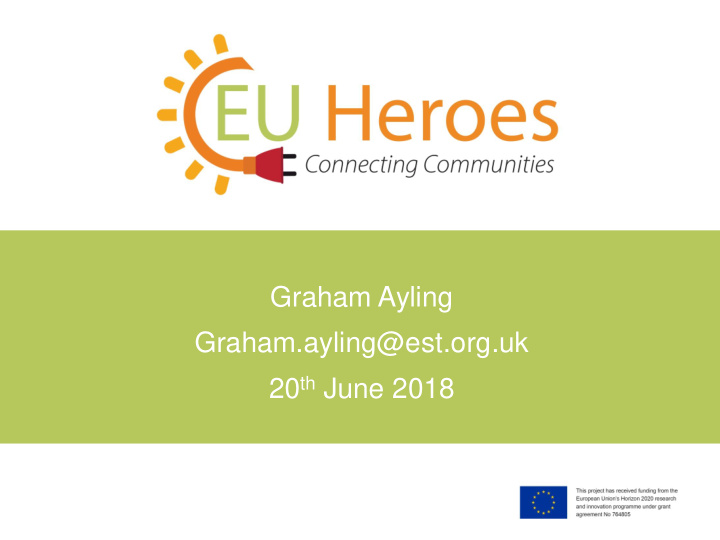



Graham Ayling Graham.ayling@est.org.uk 20 th June 2018
Prosumer Business Models for Community Solar Projects
Contents 1. What is community solar? 2. EU HEROES project 3. Energy Communities and Prosumers 4. Community Prosumer models • Community Buildings • Domestic PV • Integrated systems 5. Conclusions
What do we mean by “Community Solar”? Key characteristics of renewable energy communities: Community ownership • Owned collectively • Democratic structure – 1 member one vote • Local decision-making Community benefit • Locally held shares • Social enterprise • Community Funds • Growing in scale and professionalism
REScoop principles 7 principles of the International Co-operative Alliance: • Voluntary and Open Membership • Democratic Member Control • Economic Participation through Direct Ownership • Autonomy and Independence • Education, Training and Information • Cooperation among Cooperatives • Concern for Community • www.rescoop.eu
Energy Communities in the RED Renewable Energy Directive Update agreed last Thursday Self consumption and communities • Right to produce, consume, store and sell own renewable energy, without being subject to punitive taxes or excessive red tape, • Definition of RE communities *Source:
EU HEROES project Aims • Enable increased deployment of community PV through new models enabling grid- integration Activities • Understand needs of communities and network operators • Develop new business models • Pilot those business models Funding and partnership • EU H2020 funding – 7 partners: Netherlands, Germany, Spain, Greece, UK, Lithuania, Poland
EU HEROES methodology WP1 Management and co-ordination WP3 Case study monitoring Stakeholder engagement Dissemination WP4 WP6 WP2 Business model development WP5 Piloting Business Models
EU HEROES Learning • Use of monitored case study data • Comparison of policy/regulation regimes • Develop and compare different business models • Cross-reference models and regimes • Make recommendations • www.euheroes.eu
Energy Communities = Prosumers? Not necessarily… Distinctions • “Collective” ownership rather than individual consumers • Not always self-consumption • Scaling up on commercial RES Synergies and opportunities • Local engagement of prosumers • Larger scale community prosumer models *Source:
Community prosumer examples What community prosumer models are there? • Building integrated • Domestic PV • Integrated systems *Source:
Building Integrated Community self-supply • Prosumer model for community buildings Community 3 rd Party supply • Community-owned PV supplying local authority buildings • Or Businesses • Roof-lease and PPA • Cost security • CSR benefits *Source: The Low Carbon Hub
Domestic PV Multiple domestic • Bulk purchase/aggregation models – City-wide schemes • Shared facilities – e.g. PV on flats • Virtual peer to peer trading and shared services – Online communities – Real world communities • Social enterprise models
Integrated systems Hybrid local energy systems • Domestic PV • Ground mount PV and other renewables • Embedded storage • Grid-connected storage • Demand Side Management *Source:
Integrated systems Examples of hybrid local energy systems Virtual private wire – Energy Local, UK – Balancing local demand with community hydro – Within single substation area – http://www.energylocal.co.uk/ • Local energy systems – Grid Flex Heeten, Netherlands – 75x domestic PV – 2.2MW ground mount PV – 24x domestic batteries + 200kWh grid connected battery – Testing combined virtual connection and flexibility services – https://gridflex.nl/ *Source:
Conclusions Energy community prosumer models • Can add to prosumer models: – collective ownership – social return – scale Opportunities • Consumer engagement • Local ownership and benefit • Reinvesting in low-carbon EU HEROES • Energy communities and network innovation
Thank you For more information contact: EU HEROES Co-ordinator Rebecca Leeuwen-Jones RVO, Netherlands rebecca.vanleeuwen@rvo.nl
Recommend
More recommend